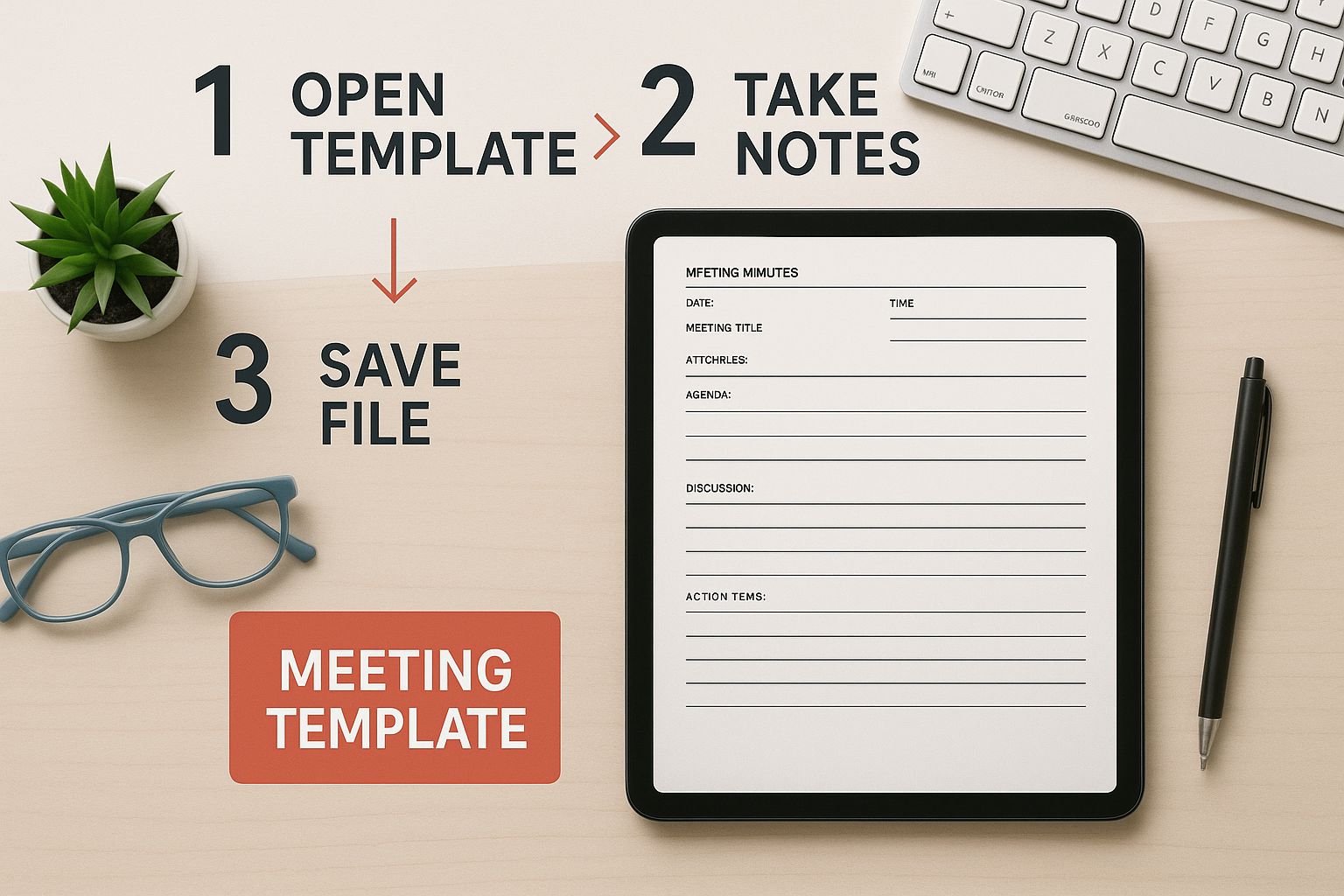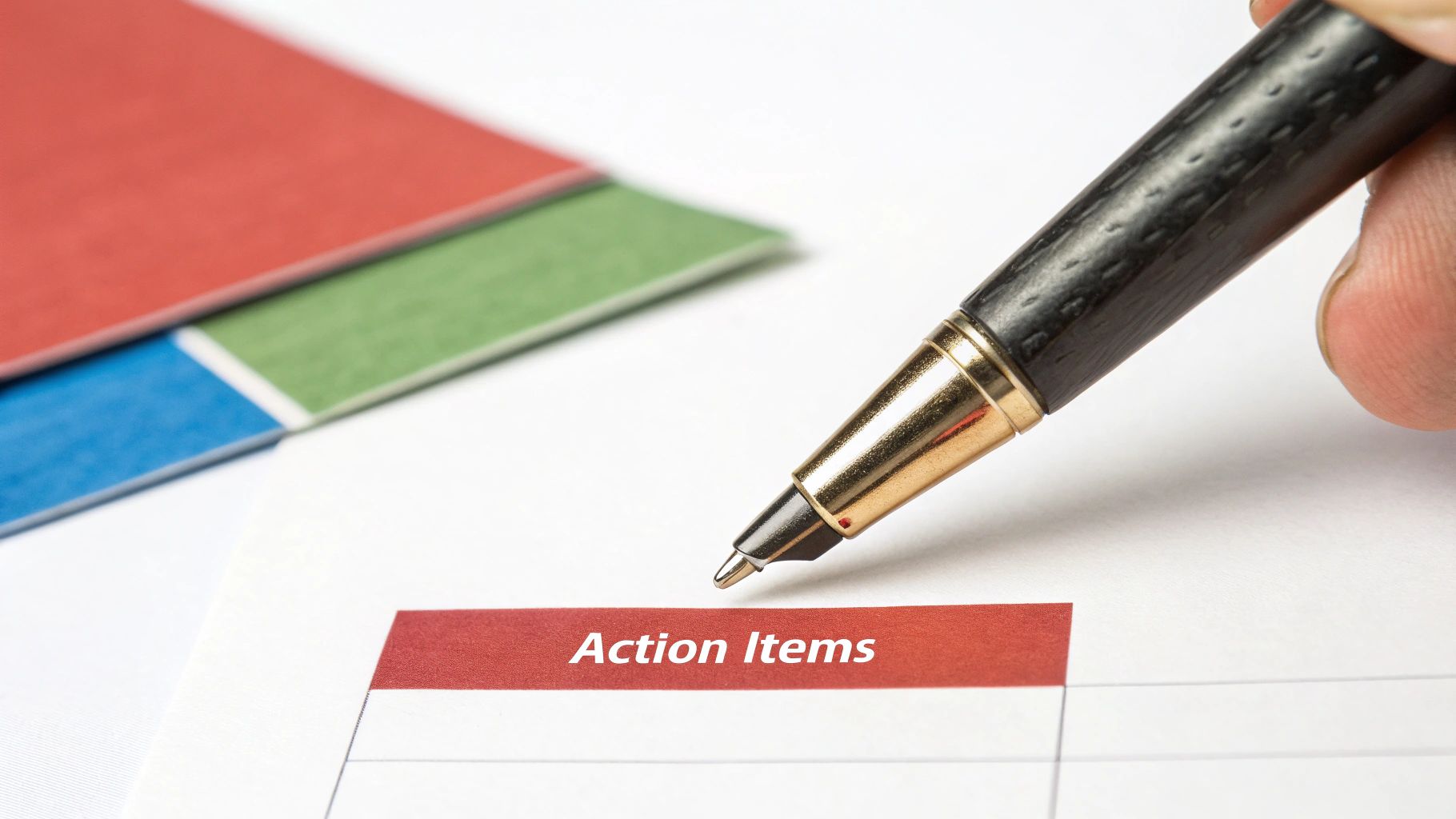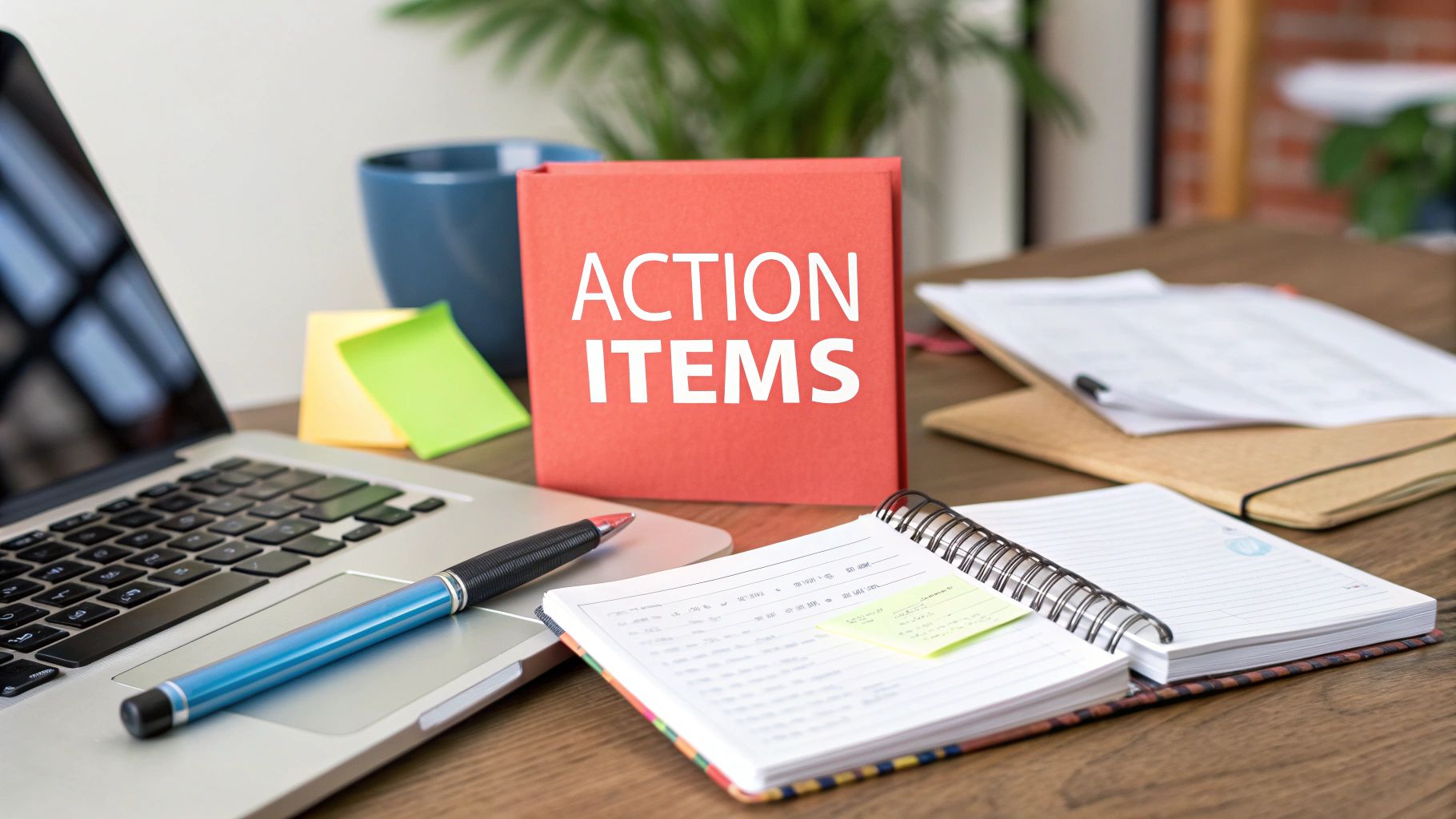A solid meeting minutes format with action items does more than just record what was said. For a fast-paced agency, it turns your notes into a genuine project management tool. It’s all about outlining client decisions, assigning clear responsibility for what comes next, and locking in deadlines so every single meeting pushes the project forward.
For a busy agency, this kind of structure is non-negotiable for keeping projects on track, clients aligned, and everyone accountable.
Why Your Agency's Current Meeting Notes Don't Work
Let's be real for a second. For most agencies, the way we handle meeting notes is completely broken.
They usually end up as one of two things: a word-for-word transcript that nobody has the time to read, or a vague collection of bullet points that doesn’t actually help anyone do anything. In a fast-paced agency world, this isn't just a minor hiccup—it's a direct threat to your deadlines and your clients' trust.
This isn't a small problem, either. With an estimated 36 to 56 million meetings happening every day in the US, a huge chunk of that time is pure waste. A 2022 study found that professionals were spending about 91 minutes per day on tasks and meetings that had nothing to do with their actual job. A structured note-taking system turns that lost time back into productive, billable hours.
The Common Note-Taking Traps for Agencies
Agencies tend to stumble into the same pitfalls over and over again with meeting notes. One of the biggest offenders is inconsistent note-taking. Your design team might capture feedback one way, while the dev team uses a totally different system. This just creates chaos and kills any chance of having a single source of truth for the project.
The other huge issue? A complete lack of ownership for next steps.
A note like "Look into new ad creatives" is totally useless. Who is doing it? When is it due? This kind of ambiguity is a direct path to scope creep, blown deadlines, and those soul-crushing "just circling back" email threads that drain your team's creative energy.
The real cost of bad meeting notes isn't just the time you waste in the meeting. It's the hours of follow-up, duplicated work, and client frustration that come after.
The Old Way vs. The Agency Way of Taking Notes
See the practical difference between standard meeting notes and an action-focused format designed for agency accountability.
Switching to an action-oriented approach gives your team clarity and shows clients you're on top of every detail.
How to Shift from Admin Chore to Project Management Tool
Seeing the problem is the first step. Ineffective notes are often a symptom of bigger issues in how teams talk to each other. Taking some time to improve team communication in general can build the foundation you need to make your meeting minutes stick.
By recognizing these common failures, you can start building a new system. The goal is to fundamentally change how you see meeting minutes—they aren't some tedious admin chore. They are a strategic tool that enforces accountability and moves projects forward, ensuring every client call and internal huddle ends with total clarity on who is doing what, and by when.
The Anatomy Of An Effective Minutes Template for Agencies

A great meeting minutes format with action items is much more than a document; it's a project management blueprint. For agencies juggling multiple clients and fast-moving projects, a standardized template is the secret to turning conversations into tangible progress. It pushes you past just noting the date and attendees and gets you focused on what actually drives work forward.
The right structure creates a clear hierarchy of information. It should start with the meeting’s core objective, flow into the key decisions made, and—most importantly—culminate in the action items. This framework guarantees every meeting ends with total clarity for the entire team.
Start With The Core Meeting Essentials
Before you even get to the discussion points, your template needs a solid foundation. This section sets the context, ensuring anyone can pick up the document weeks later and immediately understand its purpose. Think of it as the basic housekeeping that prevents a lot of future confusion.
Your template should always kick off with these non-negotiable details:
- Meeting Title: Be specific. "Client X Q3 Campaign Kickoff" is far better than a generic "Client Meeting."
- Date & Time: The exact date and time the meeting took place.
- Attendees: List everyone who was present. This is crucial for accountability.
- Meeting Objective: A single, crisp sentence explaining why you all met. For example: "To finalize the creative brief for the new product launch and assign initial tasks."
This initial block of information seems simple, but it’s powerful. It frames the entire conversation and makes your minutes easily searchable down the line.
Document Client Decisions, Not Just Discussions
This is where agency-focused minutes really diverge from standard notes. Your job isn't to create a transcript of the entire conversation. Instead, you need to zero in on the decisions that were made and, crucially, the "why" behind them.
For instance, instead of writing a long paragraph detailing a debate over a website design, document the outcome:
Decision: The team will proceed with Design Concept B for the homepage redesign.
Reason: Client feedback indicated a strong preference for its minimalist user interface and clearer call-to-action buttons, which aligns with project goals for higher conversion rates.
This approach gives vital context to team members who weren't in the room and serves as a firm record of client approvals. Documenting the reasoning is key—it prevents you from rehashing the same debates in future meetings.
Prioritize a Dedicated Section for Action Items
Okay, this is the most critical part of your template. A dedicated section for action items transforms your notes from a passive record into an active to-do list. To avoid any ambiguity, each action item has to be crystal clear.
For an action item to be effective, it must include three things:
- Specific Task: Clearly define what needs to be done.
- Single Owner: Assign the task to one person.
- Firm Deadline: Set a clear due date. No wiggle room.
A task like "Finalize the client's social media content calendar for May," assigned to "Anna" with a deadline of "End of Day Friday," is perfectly actionable. To get this right, you need a strong meeting foundation, which is why sticking to essential meeting management best practices is so important.
This structure builds a repeatable process that ends every meeting with clear forward momentum. If you want to see what a finished document looks like, check out our detailed meeting minutes format sample.
Despite the obvious benefits, a surprising number of organizations still drop the ball. A global survey revealed that only about 65% of professionals consistently record meeting minutes, which points to a major gap in practice. A structured template is the easiest way to bridge that gap, making it simple to capture decisions and next steps every single time.
How to Write Action Items That Your Agency Team Will Actually Complete
Your meeting minutes format with action items is only as good as the actions themselves. Let's be honest, a vague task like "Look into social media strategy" isn't an action item. It's a wish. For a busy agency, that kind of ambiguity is a project killer, plain and simple. It leads to delays, confusion, and a whole lot of "I thought you were doing that."
Mastering the art of writing crystal-clear, accountable tasks is what separates a meeting that builds momentum from one that just creates more work.
This is where adapting the classic SMART framework for the breakneck pace of agency life comes in. Every single action item needs to be: Specific, Measurable, Achievable, Relevant, and Time-bound. This simple structure eliminates all the guesswork and empowers your team to get moving without a single follow-up question.
Need a visual? Here’s a clean, simple layout to build your template around.

This minimalist approach just underscores how important it is to have a repeatable, no-nonsense structure for every meeting.
Turn Vague Client Feedback Into Concrete Tasks
The biggest mistake I see agencies make is recording concepts instead of commands. It’s a subtle shift, but it changes everything. Let's take some typical, weak notes from a client call and turn them into definitive tasks your team can actually run with.
I've put together a few real-world examples to show you what this looks like in practice. Notice how the "After" column gives the team member everything they need to start working immediately.
Agency Example: Transforming Vague Notes Into Clear Actions
See the difference? We’ve gone from a fuzzy idea to a mini-project brief. It contains the what, the who, and the when, all in one clear sentence.
A great action item is a mini-project brief. It contains everything a team member needs to start work immediately, including the what, who, and when.
Assign a Single, Undeniable Owner to Every Task
Another classic pitfall is assigning tasks to a group. When an action item belongs to "the design team," it effectively belongs to no one. It’s the bystander effect in action—everyone assumes someone else has it covered.
Even if a task requires collaboration, one person must be the single point of accountability. This individual is responsible for getting it across the finish line, even if they need to delegate parts of it.
- Weak: Marketing team to finalize ad copy.
- Strong: Mark is responsible for finalizing the ad copy. He will gather input from Susan and David, with a final version due by Friday at 3 PM.
This small tweak in language fosters a powerful culture of ownership. For agencies juggling dozens of projects, a solid system for action item tracking is non-negotiable to make sure nothing ever slips through the cracks.
Set Deadlines That Sync With Your Agency's Project Reality
Finally, every action item needs a deadline that makes sense within the larger project timeline. A random due date is meaningless. A deadline has to be realistic and directly connected to project milestones.
Before you just pick a date, ask: "What other tasks depend on this one being finished?" This question helps you build a logical workflow. For instance, the deadline for finalizing ad copy should naturally come before the deadline for building out the ad campaign. This integrated approach turns your meeting minutes from a static document into a dynamic roadmap that actually guides the project forward.
How to Weave Technology Into Your Agency's Workflow

Let's be honest. Manually typing notes, trying to decipher someone's handwriting after the fact, and chasing people down for approvals is a massive time sink. For any fast-moving agency, these old-school habits just don't cut it.
The modern way to handle a meeting minutes format with action items is to lean on tech that kills these manual steps. You want a seamless flow that takes you from discussion to execution, making sure nothing—and I mean nothing—falls through the cracks. This creates a clear, undeniable audit trail for your team and, just as importantly, for your clients.
Use AI to Automate the Heavy Lifting of Note-Taking
The biggest leap in efficiency you can make is to automate the transcription. AI-powered tools aren't a futuristic novelty anymore; for top-performing agencies, they're just standard operating procedure. These services can capture an entire conversation from a virtual meeting with stunning accuracy.
This completely frees up your designated note-taker. Instead of frantically trying to type every single word, they can focus on what really matters: actively listening. They can pinpoint key decisions, clarify points that sound a bit fuzzy, and confirm the who, what, and when for each action item as it’s discussed. It’s a higher-value use of their time.
Plug Your Minutes Directly into Agency Project Management Tools
Getting the information down is just step one. The real magic happens when you plug that info directly into the platforms your team lives in every day. Manually copying and pasting action items from your meeting notes into a project management tool is an extra step that invites errors and kills momentum.
The best setups let you connect your meeting minutes directly to tools like Asana, Monday.com, or Jira. This connection can automatically turn your documented action items into live, trackable tasks on the right project board.
This integration is the bridge between talking about the work and actually doing the work. It closes the gap where great ideas and critical tasks usually get lost.
This creates a rock-solid, closed-loop system for accountability. A task is discussed, documented, and assigned. Within minutes of the meeting ending, it pops up in the project owner's workflow. If you want to get into the nitty-gritty of how this works, you can learn more about how to use AI for your meeting minutes. This kind of automation ensures every action has a home, a deadline, and a clear owner—the absolute bedrock of effective agency project management.
Your Agency's Post-Meeting Workflow: Distribution and Follow-Up
Look, creating a stellar set of minutes with clear action items is a huge win. Pat yourself on the back. But for a busy agency, that’s only half the battle.
The real magic happens in the follow-up. A perfectly formatted document that just gathers digital dust in a shared drive is completely useless. It’s the post-meeting workflow that separates the high-performing agencies from the ones constantly scrambling to find updates and explaining missed deadlines to clients.
The goal is to turn your minutes into a living, breathing document that actually fuels progress. When you get this right, you create a powerful cycle of accountability that keeps projects moving forward and clients happy.
Seize the "Golden Window" for Post-Meeting Distribution
Momentum is everything. After a good meeting, there's a palpable energy in the air. Don't let it fizzle out by waiting a day or two to send the recap. By then, everyone's moved on to the next fire.
There’s a “golden window” of about 1-2 hours right after a meeting ends where the conversation is still fresh. Hit send during this window.
Sending the minutes this quickly reinforces the decisions made and gives everyone an immediate, crystal-clear roadmap for what’s next. It’s a simple move that screams organization and shows both your team and your clients you're serious about getting things done.
Too many people treat writing minutes as an end-of-day chore. Flip that script. Distribute them immediately, and you turn the meeting's closing remarks into the starting pistol for the next sprint of work.
Make Your Follow-Up Email Instantly Scannable
Nobody has time to read a novel in their inbox. When you share the minutes, the email itself shouldn't just be a lazy link to the document. Think of the email body as the executive summary—designed for someone scrolling on their phone between calls.
Here's how to structure it for maximum impact:
- Key Outcomes: Kick things off with a few bullet points summarizing the big decisions. Something like, "Client officially approved the V2 homepage wireframes."
- Top-Priority Action Items: Pull out the most critical action items and list them right there in the email. Make sure to include who owns it and when it's due. This puts the most important tasks front and center.
- The Link to Everything Else: Finish with a clear, obvious link to the full minutes document for anyone who needs the finer details.
This approach respects everyone's time while making it impossible to miss the crucial takeaways.
Create an Accountability Loop Without Constant Nagging
You need a simple system for tracking progress that doesn't involve constant micromanagement. The goal isn't to chase people down asking, "Is it done yet?" The goal is to build a transparent loop where the minutes do the heavy lifting for you.
Here's a pro move: use the action items from the last meeting as the foundation for the next meeting's agenda.
Start your next client call or internal check-in with a quick review: "Alright, last week we landed on these three action items. Let’s do a quick pass on the progress for each."
This tactic is brilliant for two reasons. First, nothing ever falls through the cracks. Second, it cultivates a culture of preparation. Your team members will start showing up to meetings ready to speak to their progress, creating a powerful, forward-moving cycle that clients absolutely love to see.
Common Questions About Agency Meeting Minutes
Even with the best templates and intentions, I get it—shifting to a more structured process for meeting minutes can bring up some valid questions. For agencies juggling client demands and creative teams, finding the right balance is everything. Let's tackle these common concerns head-on to smooth things out and get everyone on board faster.
The goal isn't to add bureaucratic red tape. It's to introduce a system that genuinely saves time and kills confusion. Once your team sees how a clear meeting minutes format with action items protects them from scope creep and endless follow-ups, it becomes a much easier sell.
How Detailed Should Minutes Be for Client-Facing Meetings?
For client meetings, the aim is always clarity and alignment, not a word-for-word transcript. Think of the document as a professional record of the agreed-upon path forward. It’s a simple way to reinforce your agency's organization and proactivity.
You really only need to focus on capturing these key elements:
- Major Decisions: Clearly state any approvals given or choices made.
- Key Feedback: Summarize the client’s main points on creative work or strategy.
- Action Items: Detail next steps for both your team and the client, including owners and deadlines.
Here's a pro tip: avoid documenting internal debates or back-and-forth discussions. The final minutes should present a united front, framing everything in a positive, forward-moving tone. This simple practice builds immense client confidence.
How Can We Get Our Agency's Teams to Adopt This Format?
Adoption comes from demonstrating value, not just enforcing rules. Nobody likes being told to do more admin work. You have to frame this new format as a tool that directly benefits them by cutting down on annoying follow-up emails and protecting their time.
I've found it's best to start small. Pilot the format with one or two project teams. When they experience firsthand how clear action items prevent misunderstandings and save them from re-doing work, they'll become your biggest advocates. Integrating the template directly into your project management software also lowers the barrier to entry, making it a natural part of their existing workflow.
Who Is Responsible for Taking Minutes in an Agency Meeting?
This is something you need to decide before the meeting starts. It prevents that awkward silence when someone asks, "So, who's taking notes?"
For internal meetings, the role of note-taker can easily rotate among team members to share the load. But for client-facing meetings, this role typically falls to the Project Manager or Account Coordinator, since they are closest to the project's logistics and next steps.
The most important thing is to empower whoever is designated. They have to feel comfortable briefly pausing the conversation to say, "Let me just confirm—Ben, you're taking the lead on the wireframes, due next Tuesday?" It’s a small step that prevents major confusion later.
Stop wasting time on manual meeting notes and follow-ups. Scribbl uses AI to automatically transcribe, summarize, and generate action items from your agency's client calls, integrating them directly into your project management tools. See how much time you can save.




